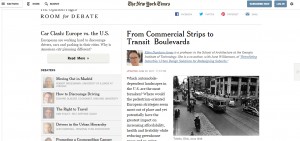Which automobile-dependent landscapes in the U.S. are the most forsaken? Where would the pedestrian-oriented European strategies seem most out of place and yet potentially have the greatest impact on increasing affordability, health and livability while reducing greenhouse gases and re-using existing infrastructure? Commercial strip corridors.
Top of the list of unloved, underperforming and ubiquitous places, they were engineered for the single purpose of swiftly moving cars. But overzoned for commercial uses, they are now clogged with cars on both local and through trips. They provide access to cheaper land and “drive till you qualify” affordable housing – but then eat up the savings as transportation costs have risen to 20 to 40 percent of household budgets. They are aging with little prospect of funding for maintenance. And their high vacancy rates just add to the dispiritedness of a failed public realm.
